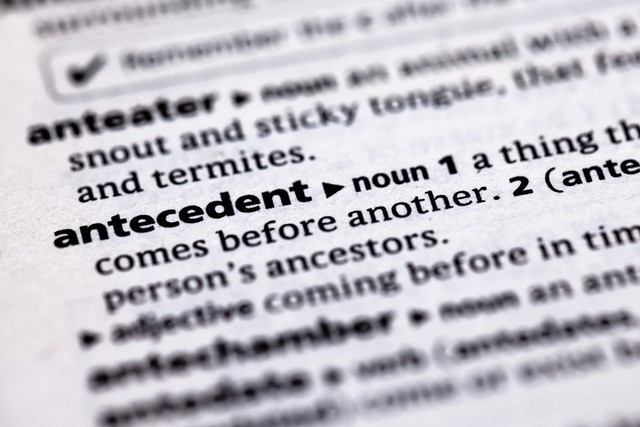
There are many grammatical terms that sound tricky but are actually quite easy to understand. Antecedents are one of these terms. In fact, you probably understand antecedents well, even if you don’t know what they are!
An antecedent is the word or phrase that is replaced by a pronoun. Here’s a very simple example:
- John walks his dog every afternoon.
His is the pronoun. We know that it refers to John. John is the antecedent.
The most important thing to understand about antecedents is agreement. In other words, the pronoun must match the antecedent. This is simple when it refers to singular and plural demonstrative or personal pronouns. We’ll define these terms shortly. But sometimes the rules aren’t as clear-cut.
Keep reading to learn everything you need to know about antecedents.
Pronoun-Antecedent Agreement
A pronoun is a word that replaces a noun. There are several types of pronouns, and they must always agree with the antecedent. Let’s take a look at the different types of pronouns and some examples of antecedent agreement.

Personal Pronouns
In English, personal pronouns may show gender or number, but never both. Female personal pronouns include she, her, hers, and herself. Likewise, male personal pronouns are he, him, his, and himself. Usually, these are for people. However, we also use these to talk about animals whose biological sex we know, and we might assign gender to items for metaphor or personification (i.e. using she to refer to a car).
- Tom has been dating Jane for three months, and he is in love with her. (Tom is the antecedent for he, and Jane is the antecedent for her.)
- I saw Maria at the store, and she was buying fruit. (Maria is the antecedent for she.)
- I can’t believe Sammy drove all by himself! (Sammy is the antecedent for himself.)
If the noun does not refer to a person, the singular personal pronouns are it, its, and itself.
- The dog is scratching its ear. (The dog is the antecedent for its.)
No matter the gender or lack thereof, we use the same plural personal pronouns to replace all plural nouns. These are they, their, theirs, them, and themselves.
- The stores have closed their doors. (The stores is the antecedent for their.)
- Millie and Mickey are twins, and they are five years old. (Millie and Mickey is the antecedent for they.)
Demonstrative Pronouns
Demonstrative pronouns allow us to refer to specific nouns or noun phrases for emphasis. The demonstrative pronouns in English are this, that, these, and those. This and that are singular, and these and those are plural. Here’s how demonstrative pronouns work with antecedents:
- Dan fell asleep in the Zoom meeting, and that is unacceptable behavior. (Fell asleep in the Zoom meeting is the antecedent for that.)
- There is butter and milk in the fridge, but those are for the cupcakes. (Butter and milk is the antecedent for those.)
Relative Pronouns
There are also relative pronouns, which begin subordinate clauses and describe antecedent. The relative pronouns are who, whom, whose, which, and that. These are used not to replace antecedent, but to add additional information. For example:
- Kevin, who is a pharmacist, helped me study for my biology exam. (Kevin is the antecedent for who.)
- The questions that the manager asked me in the interview were terrifying. (The questions is the antecedent for that.)
- The history teacher, whose name I can’t recall, said my son was acting up in class. (The history teacher is the antecedent for whose.)

Other Antecedent Agreement Rules
Rules are made to be broken, and the English language takes that very seriously! There are several instances when pronoun-antecedent agreement isn’t as straightforward as the previous examples. But we’ll explain what you need to know in simple terms.
Indefinite Pronouns
Sometimes, pronouns themselves are the antecedent. These might be indefinite pronouns, like every, neither, anybody, or someone. Usually, if the indefinite pronouns are singular, then the other pronouns that must agree are also singular.
- Neither of the dogs has had its vaccinations this year. (Neither is the antecedent to its.)
- If you buy anything from the store, make sure it’s cheap. (Anything is the antecedent to it.)
But when indefinite pronouns as antecedents refer to people, things are much trickier. The quick answer is that you can use singular or plural pronouns. All of the following examples are correct.
- Everyone hurried to his car.
- Everyone hurried to his or her car.
- Everyone hurried to their cars.
You can pick one gender for the pronoun, but you leave out anyone who isn’t that gender. This used to be the norm. You can also include both male and female pronouns. But as singular they becomes more common, you can also use the plural pronouns.
Correlative Conjunctions
Some conjunctions exist in pairs, and these are called correlative conjunctions. These often give a sentence two antecedents. In this case, only the second antecedent determines agreement.
What does this mean? In the example below, the two antecedents are bolded, and the pronoun is highlighted.
- Neither my two dogs nor my cat has eaten its dinner.
Because the second antecedent (“my cat”) is singular, we use a singular pronoun. Here’s an example where the second antecedent is plural.
- Either my manager Michelle or my supervisors will provide their feedback to the owner.
If we use the same examples but switch the order of the antecedents, notice how the agreement changes.
- Neither my cat nor my two dogs have eaten their dinner.
- Either my supervisors or my manager Michelle will provide her feedback to the owner.
This is a tricky rule, so here are a few other examples. Again, the two antecedents are bolded, and the pronoun is highlighted.
- Neither my parents nor my sister could guess what her gift was.
- Either the principal or the teachers can recommend their students for the scholarship.
- Not only the CEO but also the three vice-presidents gave up their salary during the pandemic.
Each and Every
Typically, when there are two nouns combined with “and” as the antecedent, the pronoun is plural. For example:
- The gorilla and the chimpanzee were friends their whole lives.
But if you add the words each or every, you will use a singular pronoun.
- Each plate and bowl had a maker’s mark on its bottom.
- Every woman and girl has something that makes her special.
Why Are Antecedents Important?
Understanding pronoun-antecedent agreement ensures that your writing is as clear as possible. You want your readers to know who or what you are speaking about. Additionally, pronoun-antecedent agreement works in conjunction with subject-verb agreement to allow our writing to flow correctly.
ProWritingAid helps check for pronoun consistency. You can find the pronoun report under “More Reports” in the editing tool.
Did you learn something about antecedents from this article? Let us know in the comments!


